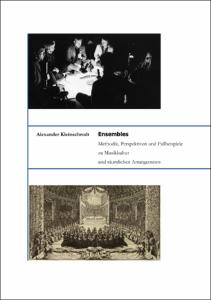EnsemblesMethodik, Perspektiven und Fallbeispiele zu Musikkultur und räumlichen Arrangements

Ensembles
Methodik, Perspektiven und Fallbeispiele zu Musikkultur und räumlichen Arrangements

| dc.contributor.advisor | Schlüter, Bettina | |
| dc.contributor.author | Kleinschrodt, Alexander | |
| dc.date.accessioned | 2023-04-20T15:10:06Z | |
| dc.date.available | 2023-04-20T15:10:06Z | |
| dc.date.issued | 20.04.2023 | |
| dc.identifier.uri | https://hdl.handle.net/20.500.11811/10781 | |
| dc.description.abstract | In der kulturwissenschaftlichen Musikforschung wird bereits seit den 1980er Jahren eine engere Verknüpfung von Musik und kulturellem Kontext gefordert. Jedoch fehlt es weiterhin an Ansätzen, die es erlauben, Kontexte von Musik anhand einer kohärenten Methodik zu untersuchen. Ausgehend unter anderem von raumsoziologischen Überlegungen Martina Löws und dem von Christopher Small entwickelten integralen Blick auf Musikkultur (die ihm zufolge aus vielfältigen Akten des „musicking“ entsteht) wird daher hier der Begriff des Ensembles eingeführt: Damit ist nicht mehr eine Musikformation gemeint, sondern das organisierte Nebeneinander von Menschen und Dingen, innerhalb dessen Musik sich als ein lebensweltlicher Gegenstand erst konkretisiert und bestimmte Funktionen erfüllen kann. Drei abschließende Fallstudien zeigen, dass dieses Konzept auf frühneuzeitliche Musikkultur ebenso angewandt werden kann, wie auf avancierte Kunstmusik des 20. Jahrhunderts und Phänomene der aktuellen Medienkultur. Deshalb versteht sich diese Arbeit auch als methodologischer Beitrag zu einer „new cultural history of music“. | en |
| dc.description.abstract | Already since the 1980s, there is a call for a closer link between music and cultural context in music studies. However, there is still a lack of approaches that allow the contexts of music to be examined using a coherent method of description. Therefore, the concept of the ensemble is introduced here. It is based mainly on Martina Löw's foundational thoughts on a sociology of space and Christopher Small's integral approach to musical culture, which in his view consists of diverse acts of "musicking". An ensemble is, in this sense, not any musical formation, but an organised juxtaposition of human beings and things, within which music can be experienced as an element of everyday life and can fulfil certain functions. As a conclusion, three case studies show that this concept can be applied to early modern musical culture as well as to advanced art music of the 20th century and phenomena of current media culture. This research project is, consequentially, also to be understood as a methodological contribution to a new cultural history of music. | en |
| dc.language.iso | deu | |
| dc.rights | In Copyright | |
| dc.rights.uri | http://rightsstatements.org/vocab/InC/1.0/ | |
| dc.subject | Musikkultur | |
| dc.subject | Kulturgeschichte der Musik | |
| dc.subject | Raumtheorie | |
| dc.subject | Aufführungspraxis | |
| dc.subject | Konzertwesen | |
| dc.subject | Medienkultur | |
| dc.subject | music | |
| dc.subject | new cultural history of music | |
| dc.subject | cultural studies | |
| dc.subject | theory of space | |
| dc.subject | performance practice | |
| dc.subject.ddc | 780 Musik | |
| dc.title | Ensembles | |
| dc.title.alternative | Methodik, Perspektiven und Fallbeispiele zu Musikkultur und räumlichen Arrangements | |
| dc.type | Dissertation oder Habilitation | |
| dc.publisher.name | Universitäts- und Landesbibliothek Bonn | |
| dc.publisher.location | Bonn | |
| dc.rights.accessRights | openAccess | |
| dc.identifier.urn | https://nbn-resolving.org/urn:nbn:de:hbz:5-70530 | |
| ulbbn.pubtype | Erstveröffentlichung | |
| ulbbnediss.affiliation.name | Rheinische Friedrich-Wilhelms-Universität Bonn | |
| ulbbnediss.affiliation.location | Bonn | |
| ulbbnediss.thesis.level | Dissertation | |
| ulbbnediss.dissID | 7053 | |
| ulbbnediss.date.accepted | 25.07.2022 | |
| ulbbnediss.institute | Interdisziplinäre Zentren : Zentrum für Kulturwissenschaft / Cultural Studies (ZFKW) | |
| ulbbnediss.fakultaet | Philosophische Fakultät | |
| dc.contributor.coReferee | Fischer, Erik | |
| ulbbnediss.contributor.gnd | 174389701 |
Files in this item
This item appears in the following Collection(s)
-
E-Dissertationen (712)




